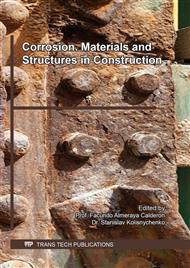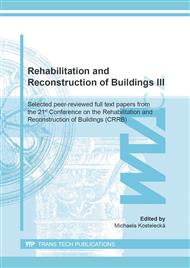[1]
NOVAK, P., MALA, R., JOSKA, L., Influence of pre-rusting on steel corrosion in concrete. Cement and Concrete Research, Volume 31, Issue 4, Pages 589-893, ISSN: 0008-8846, (2001).
DOI: 10.1016/s0008-8846(01)00459-8
Google Scholar
[2]
KOURIL, M., NOVAK, P., BOJKO, M., Limitations of the linear polarization method to determine stainless steel corrosion rate in concrete environment. Cement and Concrete Composites, Volume 28, Issue 3, Pages 220-225, ISSN: 0958-9465, (2006).
DOI: 10.1016/j.cemconcomp.2006.01.007
Google Scholar
[3]
CUSENS, A., YU, Z., Pullout tests of epoxy-coated reinforcement in concrete. Cement and Concrete Composites, Volume 14, Issue 4, Pages 269-276, ISSN: 0958-9465, (1992).
DOI: 10.1016/0958-9465(92)90025-q
Google Scholar
[4]
POKORNY P., TEJ, P., KOURIL, M., Evaluation of the impact of corrosion of hot-dip galvanized reinforcement on bond strength with concrete – A review. Construction and Building Materials, Volume 132, Pages 271-289, ISSN: 0950-0618, (2017).
DOI: 10.1016/j.conbuildmat.2016.11.096
Google Scholar
[5]
GALLEGO, A., et al., Comparison between concrete-black steel and concrete galvanized steel bond via the pull-out test supplied with acoustic emission. Conference EWGAE (poster 3), Pages 761-767, (2004).
Google Scholar
[6]
POKORNY, P., PERNICOVA, R., TEJ P., KOLISKO, J., Changes of bond strength properties of hot-dip galvanized plain bars with cement paste after 1 year of curing. Construction and Building Materials, Volume 226, Pages 920-931, ISSN: 0950-0618, (2019).
DOI: 10.1016/j.conbuildmat.2019.07.147
Google Scholar
[7]
BIRD, C. E., The influence of minor constituents in Portland cement on the behaviour of galvanized steel in concrete. Corrosion Prevention & Control, Pages 17-21, (1964).
Google Scholar
[8]
MANG, R., MULLER, R. H., Untersuchungen zur Anwendbarkeit feuerverzinkter Bevehrung im Stahlbeton-bau. Stahl und Eisen, Pages 889-894, (1982).
Google Scholar
[9]
CORDEROY, D. J. H., HERZOG, H., Passivation of galvanized reinforcement by inhibitor anions. Corrosion of reinforcing steel in concrete, ASTM, Pages 142-159, (1978).
DOI: 10.1520/stp27474s
Google Scholar
[10]
FAYALA, I., DHOUIBI, L., NÓVOA, X. R., OUEZDOU, M. BEN, Effect of inhibitors on the corrosion of galvanized steel and on mortar properties. Cement and Concrete Composites, Volume 35, Issue 1, Pages 181-189, ISSN: 0958-9465, (2013).
DOI: 10.1016/j.cemconcomp.2012.08.014
Google Scholar



